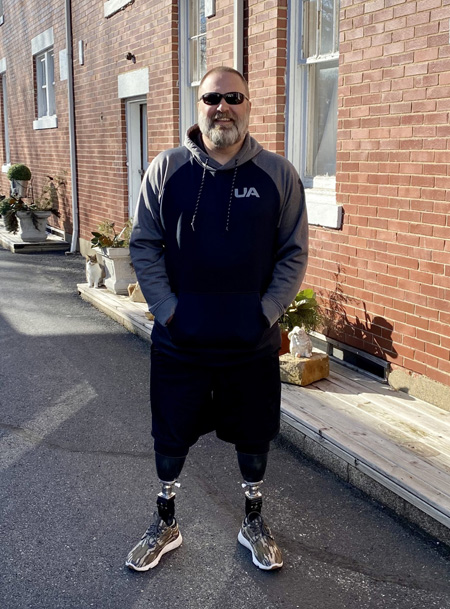by Paul Govern
Alyssa Thompson’s route to specialty care for chronic pain, and to a small device being permanently implanted in her midback to manage pain by delivering imperceptible electrical pulses to her spinal cord, began with a gymnastics session in her backyard in Murfreesboro, Tennessee, in 2012 at age 14.
Tumbling resulted in an ankle sprain that would launch years of medical interventions for complex regional pain syndrome.

Brannon Lockhart’s route to receiving a spinal cord stimulator implant for chronic pain was by way of a genetic condition that disposes him and other family members to form blood clots in their circulatory system. In Lockhart’s case, the condition led to painful loss of circulation in his lower legs, and to amputation below the knee — his right leg in January 2019, his left in July 2020. (Between these two surgical treatments, Lockhart’s 21-year-old daughter, Lindsay, died after undetected blood clots caused a blood vessel in her brain to rupture.)
First reported in the 1960s, the application of electrical pulses to treat pain has grown dramatically over the past decade, with some 34,000 spinal cord stimulators per year now implanted worldwide, half of them in North America. According to Fortune Business Insights, the global spinal cord stimulation devices market, which in 2020 dipped sharply to $2.4 billion due to the COVID-19 pandemic, is expected to grow 8% per year and reach $4.1 billion by 2027. Typical indications include post-laminectomy syndrome (also known as failed back surgery syndrome), complex regional pain syndrome, and peripheral neuropathy, that is, diseases of or damage to nerves beyond the brain and spinal cord.

“We’re not turning off any neurons, or any ability for the spine and brain to communicate with a painful part of the body,” said interventional pain specialist Chris Sobey, MD, associate professor of Clinical Anesthesiology, who placed Thompson’s implant in 2018. “We’re trying to impede specific pain signals from too aggressively communicating. My analogy is, it’s like having a neural highway and you’re putting speed bumps on it: you still have cars going down that highway, but they’re going a lot slower and a lot less aggressively.”
Pain specialists at Vanderbilt University Medical Center implanted 130 spinal cord stimulators last year. In a typical case, a device about the size of an Oreo cookie is surgically implanted in the midback, with electrodes being run out to targets in the epidural space of the spine, adjacent to the spinal cord. A form of neuromodulation, spinal cord stimulation can help patients for whom pain medication is inadequate or poses debilitating side effects.
“We spent six and a half years trying every single thing we could think of, just to make it through each day,” said Thompson, director of operations at a financial services firm. She says chronic pain affected all aspects of her life. She was homebound for a time, receiving high school instruction via teachers’ home visits. She periodically received epidural injections to numb her legs, followed by stints of physical therapy at Monroe Carell Jr. Children’s Hospital at Vanderbilt.
With the implant, “I had relief almost immediately,” she said. “I was suddenly able to do everything that I wanted to, and I’d never really had that since before I was 14. It changed everything in my life.”
Lockhart’s implant was placed last November by interventional pain specialist Jeremy Walker, MD, assistant professor of Clinical Anesthesiology.
“It’s been totally life changing for me,” said Lockhart, a business consultant and an avid hunter. During a Zoom interview, to demonstrate the agility afforded by his artificial lower legs, the U.S. Army veteran rose and moved jauntily about his home office.
Before the implant, Lockhart had been taking opioids on a daily basis.
“I went from six or seven hydrocodones a day to, now, maybe one or half of one every couple days. And I’m probably 80% to 85% more active now.”
Implantation at VUMC is preceded by a psychological evaluation and a weeklong trial involving an external generator. Permanent placement involves an outpatient procedure and twilight sedation, similar to that used for a colonoscopy. The implants last about 10 years, Walker said. Patients use a small remote control to select device settings.
With the advances achieved in neuromodulation, “We now use waveforms and programming that doesn’t give any vibratory or tingling sensation or pose any sensation at all for the patient,” Walker said.
A majority of people historically treated with spinal cord stimulators at VUMC have refractory low-back and leg pain, Walker said, often after spine surgeries. He added that the use of neuromodulation to treat complex regional pain syndrome is growing. Walker describes this syndrome, which is estimated to affect some 200,000 people in the U.S. annually, as “a remodeling of the nervous system that leads to haywire pain signals, usually in a foot or an arm.”
A majority of VUMC spinal cord stimulation implants are performed by the team at the Center for Neuromodulation Clinic, with two locations in Franklin, Tennessee. The clinic, which sees patients by clinician referral, also offers other minimally invasive pain interventions.












